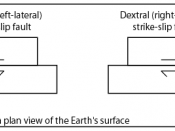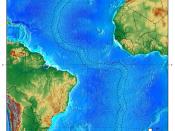Earthquakes 1
Earthquakes
Jessica Svorinich
Axia College University of Phoenix
2
Earthquakes
The Red Sea is an example of Divergent Margins. Divergent margins are a result of two
lithospheric plates that move apart. These Divergent Margins can occur either in continental or oceanic crust.
Schematic diagram of plate divergence. U.S. Geological Survey image.
A divergent zone happens when the plates are pulled apart, not pushed apart. The circumstances that cause a divergent zone is " "slab pull" that arises where plates sink into the mantle under their own weight." This process is known as subduction. The divergent zone pulling motion can uncover the deep mantle rock of the asthenosphere.
This magma then freezes onto the trailing edges of the diverging plates, and so the plates grow."
http://geology.about.com/library/bl/blnutshell_divergence.htm Says "Lithospheric Plates diverge at a wide range of speeds, giving rise to differences in spreading ridges. Slow-spreading ridges like the Mid-Atlantic Ridge have steeper-sloping sides because it takes less distance for their new lithosphere to cool. They have relatively little magma production so that the ridge crest can develop a deep dropped-down block, a rift valley, at its center. Fast-spreading ridges like the East Pacific Rise make more magma and lack rift valleys.
One fact not widely appreciated is that divergent margins move sideways just like the plates themselves do.
Divergent margins are passive windows into the asthenosphere, releasing magmas from below wherever they happen to wander. While textbooks often say that plate tectonics is part of a convection cycle in the mantle, that notion cannot be true in...


